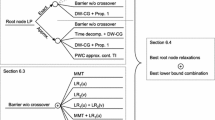Abstract
We design a fast ascent direction algorithm for the Lagrangian dual problem of the single-machine scheduling problem of minimizing total weighted completion time subject to precedence constraints. We show that designing such an algorithm is relatively simple if a scheduling problem is formulated in terms of the job completion times rather than as an 0–1 linear program. Also, we show that upon termination of such an ascent direction algorithm we get a dual decomposition of the original problem, which can be exploited to develop approximative and enumerative approaches for it. Computational results exhibit that in our application the ascent direction leads to good Lagrangian lower and upper bounds.
Similar content being viewed by others
References
D. Adolphson and T.C. Hu, “Optimal linear ordering,”SIAM Journal of Applied Mathematics 25 (1973) 403–423.
E. Balas and N. Christofides, “A restricted Lagrangean approach to the traveling salesman problem,”Mathematical Programming 21 (1981) 19–46.
O. Bilde and S. Krarup, “Sharp lower bounds and efficient algorithms for the simple plant location problem,”Annals of Discrete Mathematics 1 (1977) 79–88.
N. Christofides, “The shortest hamiltonian chain of a graph,”SIAM Journal of Applied Mathematics 19 (1970) 689–696.
M.E. Dyer and L.A. Wolsey, “Formulating the single-machine sequencing problem with release dates as a mixed integer program,”Discrete Applied Mathematics 26 (1990) 255–270.
D. Erlenkotter, “A dual-based procedure for uncapacitated facility location,”Operations Research 21 (1978) 1114–1127.
M.L. Fisher, “A dual algorithm for the one-machine scheduling problem,”Mathematical Programming 11 (1976) 229–251.
M.L. Fisher, “The Lagrangian relaxation method for solving integer programming problems,”Management Science 27 (1981) 1–18.
M.L. Fisher, “An application oriented guide to Lagrangian relaxation,”Interfaces 15 (1985) 10–21.
M.L. Fisher, R. Jaikumar and L.N. van Wassenhove, “A multiplier adjustment method for the generalized assignment problem,”Management Science 32 (1986) 1098–1103.
M.L. Fisher and P. Kedia, “Optimal solution of set covering/partitioning problems using dual heuristics,”Management Science 36 (1990) 674–688.
A.M. Geoffrion, “Lagrangian relaxation and its uses in integer programming,”Mathematical Programming Study 2 (1974) 82–114.
R.L. Graham, E.L. Lawler, J.K. Lenstra and A.H.G. Rinnooy Kan, “Optimization and approximation in deterministic sequencing and scheduling: a survey,”Annals of Discrete Mathematics 5 (1979) 287–326.
M. Guignard and K. Spielberg, “A direct dual method of the mixed plant location problem with some side constraints,”Mathematical Programming 17 (1979) 198–228.
A.M.A. Hariri and C.N. Potts, “An algorithm for single-machine sequencing with release dates to minimize total weighted completion time,”Discrete Applied Mathematics 5 (1983) 99–109.
A.M.A. Hariri and C.N. Potts, “Algorithms for two-machine flow-shop sequencing with precedence constraints,”European Journal of Operational Research 17 (1984) 238–248.
M. Held and R.M. Karp, “The traveling salesman problem and minimum spanning trees,”Operations Research 18 (1970) 1138–1162.
M. Held and R.M. Karp, “The traveling salesman problem and minimum spanning trees: Part II,”Mathematical Programming 1 (1971) 6–25.
M. Held, P. Wolfe and H. Crowder, “Validation of subgradient optimization,”Mathematical Programming 6 (1974) 62–88.
J.A. Hoogeveen and S.L. van de Velde, “Stronger Lagrangian bounds by use of slack variables: applications to machine scheduling problems,”Mathematical Programming 70 (1995), to appear.
W.A. Horn, “Single-machine job sequencing with treelike precedence ordering and linear delay penalties,”SIAM Journal of Applied Mathematics 23 (1972) 189–202.
E.L. Lawler, “Sequencing jobs to minimize total weighted completion time subject to precedence constraints,”Annals of Discrete Mathematics 2 (1978) 75–90.
E.L. Lawler, “Efficient implementation of dynamic programming algorithms for sequencing problems,” Report BW 106, Centre for Mathematics and Computer Science (Amsterdam, 1979).
J.K. Lenstra and A.H.G. Rinnooy Kan, “Complexity of scheduling under precedence constraints,”Operations Research 26 (1978) 22–35.
T.E. Morton and B.G. Dharan, “Algoristics for single-machine sequencing with precedence constraints,”Management Science 24 (1978) 1011–1020.
C.N. Potts, “A Lagrangean based branch-and-bound algorithm for single machine sequencing with precedence constraints to minimize total weighted completion time,”Management Science 31 (1985) 1300–1311.
C.N. Potts and L.N. van Wassenhove, “An algorithm for single-machine sequencing with deadlines to minimize total weighted completion time,”European Journal of Operational Research 33 (1983) 363–377.
C.N. Potts and L.N. van Wassenhove, “A branch and bound algorithm for the total weighted tardiness problem,”Operations Research 33 (1985) 363–377.
M. Queyranne and A.S. Schulz, “Polyhedral approaches to machine scheduling,” Working paper, Technische Universität Berlin (Berlin, 1994).
M. Queyranne and Y. Wang, “Single-machine scheduling polyhedra with precedence constraints,”Mathematics of Operations Research 16 (1991) 1–20.
M. Queyranne and Y. Wang, “A cutting plane procedure for precedence constrained single-machine scheduling,” Working paper, University of British Columbia (Vancouver, 1991).
L. Schrage and K.R. Baker, “Dynamic programming solution of sequencing problems with precedence constraints,”Operations Research 26 (1978) 444–449.
J.F. Shapiro, “A survey of Lagrangian techniques for discrete optimization,”Annals of Discrete Mathematics 5 (1974) 113–138.
J.B. Sidney, “Decomposition algorithms for single-machine sequencing with predecence relations and deferral costs,”Operations Research 23 (1975) 283–298.
W.E. Smith, “Various optimizers for single-stage production,”Naval Research Logistics Quarterly 3 (1956) 59–66.
S.L. van de Velde, “Minimizing the sum of the job completion times in the two-machine flow shop by Lagrangian relaxation,”Annals of Operations Research 26 (1990) 257–268.
S.L. van de Velde, “Machine scheduling and Lagrangian relaxation,” Ph.D. Thesis, CWI (Amsterdam, 1991).
L.A. Wolsey, “Formulating single-machine scheduling polyhedra with precedence constraints,” in: J. Gabszewicsz, J.-F. Richard and L.A. Wolsey, eds.,Economic Decision-Making: Games, Econometrics and Optimization (North-Holland, Amsterdam, 1990).
Author information
Authors and Affiliations
Rights and permissions
About this article
Cite this article
van de Velde, S.L. Dual decomposition of a single-machine scheduling problem. Mathematical Programming 69, 413–428 (1995). https://doi.org/10.1007/BF01585568
Received:
Revised:
Issue Date:
DOI: https://doi.org/10.1007/BF01585568




